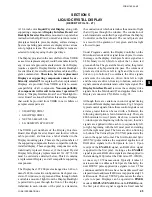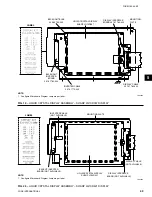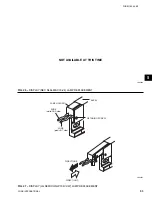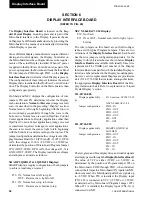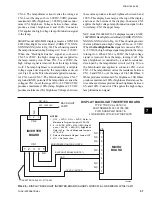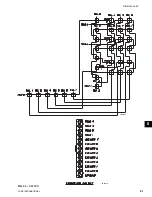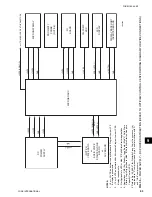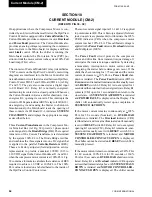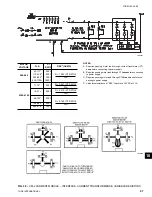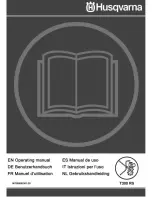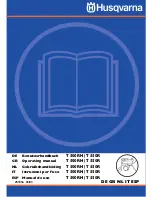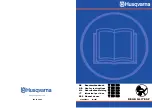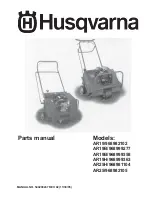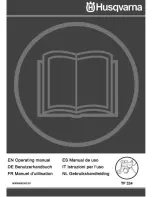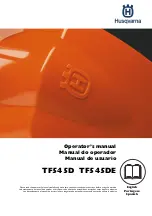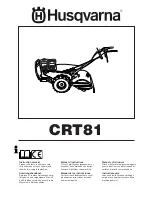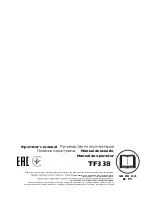
FORM 160.54-M1(503)
59
YORK INTERNATIONAL
SECTION 8
KEYPAD
(REFER TO FIGURES 32 & 33)
The
Keypad
contains touch-sensitive keys that allow the
Operator to interface with the OptiView Control Center.
The Operator presses the keys to request the desired
screens of information and enter System Setpoints.
The top layer of the Keypad contains embossed areas
identifying the keys. Under each embossed key area
are two conductors, one on top of the other, separated
by an air space. The conductors are arranged in a ma-
trix of rows and columns and connected to the Key pad
connector as shown in Fig. 32. The em bossed area of
each key is located directly over the in ter sec tion point
of the conductors. Pressing the embossed key area
caus es contact and electrical continuity between the
two conductors. For example, pressing the “1” key
creates con ti nu ity between the Keypad connector pin
5 (col umn 3) and pin 13 (row 4). Since this connector
is in ter faced to the Microboard (J18), the Microboard
sens es this continuity as described below and con cludes
the “1” key is pressed.
The Microboard Program continuously scans the Key-
pad to determine if a key is pressed. Beginning with
row 1 and proceeding through all rows, the Program
places a “logic low” (<1VDC) on a row, a “logic high”
(>4VDC) on the remaining rows and reads the col umns.
A logic low in any column indicates a key in that col umn
and row is pressed. For example, if at the time row 4
is being driven low, if column 3 is low, then the Micro
con cludes the key at co or di nate of row 4 and column 3
is pressed. Since the co or di nates of all keys are stored
in the Microboard’s Program, it can iden ti fy which key
is at this co or di nate and responds ac cord ing ly. In this
ex am ple the “1” key is pressed.
In order for the Microboard to reliably detect closed and
open keys, each key must meet a closed circuit and open
circuit resistance requirement. When a key is pressed, the
contact resistance must be < 100 Ohms. When a key is
not pressed, the contact resistance must be > 1Meg Ohm.
If the Microboard is not responding to a pressed key, or
if it’s detecting a closed key when none are pressed, it
could be be cause the contact re sis tance requirements are
not being met. The operation of each key can be checked
with an Ohmmeter. To check the open and closed con-
tact resistance of any key, re fer to the “Di ag nos tics and
Troubleshooting” Section 23 of this book.
The Keypad is attached to the front of the OptiView
Control Cen ter door with an adhesive backing. If ser vice
re place ment is required, start at one corner and slowly
peel the Keypad from the door. The rear side of the re-
place ment Keypad is coated with an adhesive covered
with a paper backing. Remove the paper back ing, align
the Display and rocker switch openings and apply the
Key pad to the door.
8
Summary of Contents for MAXE OPTIVIEW YK
Page 28: ...YORK INTERNATIONAL 28 FORM 160 54 M1 503 Microboard FIG 7 MICROBOARD LD07776...
Page 60: ...YORK INTERNATIONAL 60 FORM 160 54 M1 503 Keypad FIG 32 KEYPAD CONNECTOR LD04074...
Page 61: ...FORM 160 54 M1 503 61 YORK INTERNATIONAL FIG 33 KEYPAD LD04075 LD04076 8...
Page 173: ...FORM 160 54 M1 503 173 YORK INTERNATIONAL 26 This page intentionally left blank...
Page 177: ...FORM 160 54 M1 503 177 YORK INTERNATIONAL 26 This page intentionally left blank...

